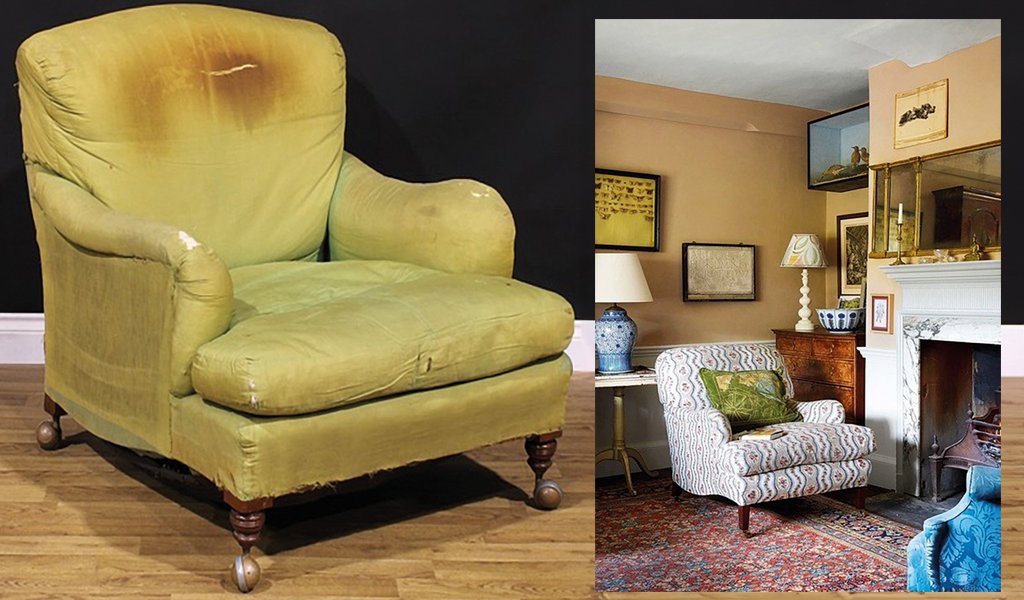By Vivienne Milburn FRICS Independent Antiques Auctioneer & Valuer
If you are clearing out your clutter this January, you might want to think twice before consigning items to the bonfire, writes Vivienne Milburn.
DISCOVERED during a house contents’ valuation in Derbyshire, the damaged armchair we have pictured only just escaped the bonfire. Fortunately, when I was asked to value it, I recognised that its very broad seat could be an indication of a Howard & Sons chair. A characteristic of Howard armchairs is that they have very broad seats. The armchair made £6,250 when it was included in a Fine Antique Furniture auction recently.
Howard & Sons have been making seating for more than 200 years. They make some of the most comfortable chairs to be found at auction. Getting a Howard chair is a must for any traditional English interior. The Howard chair is actually one in a range of chairs and sofas called Bridgewater type. The Deep-Seated Bridgewater armchair was the ‘original’ Bridgewater chair, and it is the most recognisable shape, as well as the most copied. It’s the one we think of when we mention a Howard chair: low and curved, with a generous seat, curved and padded armrests and headrest. An armchair that has proved to be an enduring investment through the years.
At present, we are in an upholstery revival, as more antique furniture is rejuvenated by some animal skin fabric upholstery. When assessing upholstered furniture, the understanding is that if a piece has sprung upholstery, it is either Victorian or a later date, as original Georgian upholstery is padded with horsehair and with no metal springs. It is widely thought that the craft of upholstery evolved from that of the tent-maker, although tent-making is now quite a separate craft.
The Guild of Upholsterers’ Company was granted a charter in 1626 and its coat of arms is a shield with three tents. One of the early developments from tent-making was ‘wall hangings’ and draperies at windows and around beds. In the past, part of the upholsterer’s jurisdiction also included carpets, curtains and coffin linings!
The first signs of comfort for chairs came with the making of cushions, but it was not until the reign of Queen Elizabeth I that the stuffing of furniture began to evolve. From then on, the craft of upholstery increased and was in great demand, reaching its peak in the late Victorian era and early Edwardian days. By this time the standard of workmanship and versatility in England was really magnificent.
A ‘journeyman upholsterer’ was known as a ‘stuffer’, and he built up from a frame a piece of furniture padded with stuffing. He would have gone to work in his top hat and spats, which was a symbol of the prestige in which the craft was held. Working conditions have improved tremendously, as during the 1930s the ‘stuffer’, or ‘ragtacker’ as he was called, probably experienced the worst conditions. These were prevalent wherever there was great unemployment and ‘sweat shops’ sprang up all over the country to keep pace with demand.
A lot of tedious jobs for the upholsterer have been eliminated by the manufacture of spring units, ready-shaped padding and rubberized hair that can be cut off a roll. For a first-class job and to cover your antique furniture with the ‘on trend’ animal print fabric, or a modern take on patchwork and bright colours, it remains a skilled craft, with the final stages created with great satisfaction.
Howard & Sons were one of the best upholstered chair makers of the Victorian era. In 1848, Howard & Sons started trading from Berners Street, London, describing themselves as cabinet makers, upholsterers and decorators. They won international recognition at the Great Exhibition of 1852 and were gold medal winners at the Paris Exhibition of 1900.
Classic Howard & Sons upholstered furniture has such a good solid frame that they lend themselves particularly well to being re-upholstered in a fashionable fabric.
Howard & Sons upholstered furniture can be found in Royal households, they also worked with Gillows of Lancaster and other quality cabinet makers such as Maple & Co (1870-1950), one the largest and most successful British furniture retailers and cabinet makers in the Victorian and Edwardian periods.
They were well known for fine quality, craftsmanship and were specialists in copying old designs but bringing them up to date to fit with the more modern trends. They produced many quality pieces of furniture in Hepplewhite and Chippendale designs but also were well known for their quality Arts & Crafts furniture. By the 1880s, they were the largest furniture store in the world as they exported their fine antique furniture to many different countries.
The firm rapidly established a reputation for supplying high quality furniture to the richest families in the country; and examples can be seen at Chatsworth House.
Editor’s Note: If you have antiques and collectables and you would like to place your items in an appropriate specialist auction, it is worth getting the advice of an Independent Antiques Valuer to assess your items. For further information, please contact Vivienne on 01629 640210 or 07870 238788. Alternatively, go to www.viviennemilburn.co.uk or email vivienne@viviennemilburn.co.uk






